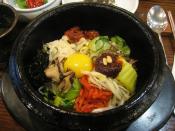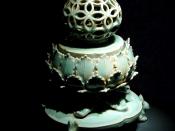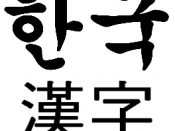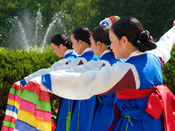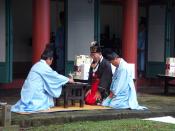"Ch'oe spread the notion that the west could be warded off by using its' strongest weapon, GOD (Ch'onju), for developing national power, and he proclaimed himself the savior of the nation." This quote from the early 1860's was intended to inspire the Korean people to unite against the intrusion of foreign ideas and influences controlling Korea's government seen as the precursor to colonialism. Ch'oe created a tool through which the peasants could voice their discontent on issues of heavy taxation, official extortions, and widespread corruption all of which added to the instability and tension of the region. This tool was Tonghak which was a movement designed to dismantle the privileges of the establishment and replace the greed and selfishness of power and wealth with reflections of the divine respecting equality and dignity. Ch'oe implemented the teachings of Tonghak through a social revolution which he spread as he traveled amongst the peasant farmers and other members of lower strata gaining popularity by talk of easing their social and economical barriers placed upon them by the government.
Implications of Tonghak focused on freeing the Korean society of it's ills with the abolishment of discrimination, creation of civil rights, and removal of dictatorial control by the government over the people. Ch'oe instated his ideas through protest and peasant uprisings aimed at the oppression placed upon them by both the government and its political alliance with foreign powers such as Japan and China. These demonstrations eventually led to the government suppression of the Tonghak movement and the execution of Ch'oe and faithful followers in 1864. His death was however not the end, but rather the beginning of an underground community still devoted to Ch'oe's simplistic message of a Korea free of oppression.
At the same time, the religious aspect of the Tonghak, the Chondokoyo ( Society of the Heavenly Way), which embodied features selected from other religions such as Confucianism's disregard of immortality, Buddhism's law of heart cleansing, Monotheism from Christianity along with elements of shamanism, provided a common bond among the many sects within the populace. Like the Tonghak, the Chondokoyo was designed to instill a greater feeling of nationalism. The followers of the Chondokoyo and Tonghak can be branded as patriotic religious warriors with issues of economical and social equity as there template for a new improved goverment. Unfortunately, it too was seen as subversive and therefore outlawed by the government forcing it underground with the Tonghak.
Chondokoyo continued to receive widespread acceptance as a popular faith, and gained strength from the martyrdom of it's founder Choe in 1865. Gatherings of followers loyal to Chondokoyo massed at Poun in Ch'ungch,ong province 1893 and protested against the government calling for the punishment of corrupt officials and the expulsion of Japanese and western influences. The result of this demonstration brought about the freedom of the Chondokoyo religion, but was to be only a temporary peace. The hostilities of the peasants were, however, not eased by this as they remained in bondage and indentured to the wealthier and more powerful Yangban class, and more specifically the Min Clan oligarches. Numerous attempts were made by the peasantry to voice their grievances and feelings of discontent, but to no anvil. This led to the armed insurrection led by the leader of the Kobu perish of Tonghak, Chon Pong-jun in 1894 where occupation of the Korean government offices occurred seizing weapons and the supply of illegally collected rice from the people . Then destroyed a newly constructed reservoir which the peasants had built under serfdom.
Once the government was informed of the rebellion an official was dispatched to investigate. The leader, Chong Pong-jun was charged along with other Tonghak faithful for instigating the event with some being imprisoned and others executed. Chong Pong-jun, enraged by the investigators unjust actions, rallied the peasants and local Tonghak perishes to rise up and protest which swelled in ranks to several thousands. On April 26,1894 the peasant masses and other Tonghak followers eventually had no other course but to physically purge the corrupt Min government and drive out the Japanese from Korean soil. The insurrection was met by armed government forces, but the peasant spirit, or lack of choice, defeated the army and approached the powers-that-be with a list of demands in a manifesto issued by their leader Chong Pong-jun: " (1) Do not kill the [innocent] people; do not destroy [the people's] properties (2) Fulfill the duties of loyalty [to the sovereign] and filial piety [to the parents]; sustain the nation and provide for the people.
(3) Drive out and eliminate the Japanese barbarians and thereby restore the Way of the [Confucian] Sages.
(4) Storm into the capital in force and thoroughly cleanse [the government of] the powerful families-so as to strengthen [Confucian] moral relationships, to rectify names and roles, and to realize the teachings of the Sages." This pronunciamento forced the government to make concessions and reformed much of its policy on foreign influences which might have been successful in leading Korea in the direction of a truly independent state, However, the untimely arrival of both the Chinese and Japanese in the protection of their interests within Korea resulted in a state of war and the ultimate suppression of Korea by Japan.
The Tonghak and Chondokoyo movement was successful in uniting the Korean people, but it was too little too late for a people surrounded by the massive countries bordering them, with their own colonial ambitions for Korea.
Bibliography Eckert, Carl. Korea Old And New A History. Seoul: Ilchokak Publishing 1990 Chandra, Vipan. Imperialism, Resistance, and Reform in Late Nineteenth-Century Korea. Berkeley: University of California 1967 Osgood, Cornelius. The Koreans And Their Culture. New York: Ronald Press Company 1951 Robinson, Michael. Cultural Nationalism in Colonial Korea, 1920-1925. Seattle: University of Washington Press
